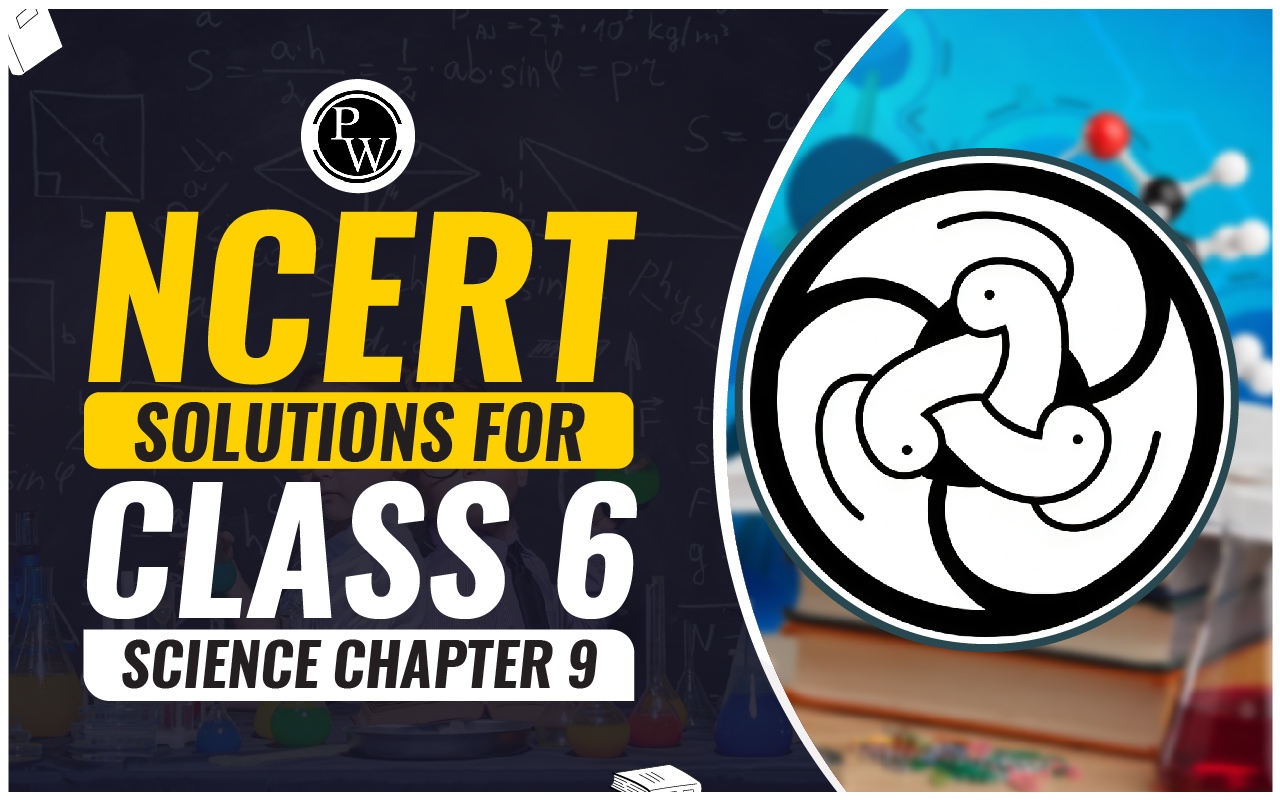

NCERT Solutions For Class 6 Science Chapter 9
NCERT Solutions For Class 6 Science Chapter 9: NCERT Solutions for Class 6 Science Chapter 9, The Living Organisms Characteristics and Habitats, are created according to the latest CBSE syllabus. The detailed answers presented here aid students in gaining full knowledge of the different places where living things reside and how they adapt to these places. These solutions will acquaint them with the environments where plants and animals exist, the sharing of living spaces, various animals in different locations, non-living components, and the shared traits of living things. These NCERT Solutions for Class 6 Science will help you establish a solid base for the more advanced topics you'll encounter in higher classes. The diverse questions in these solutions will enhance your problem-solving skills, which is crucial from an exam standpoint.NCERT Solutions For Class 6 Science Chapter 9 PDF Download
NCERT Solutions for Class 6 Science Chapter 9 Overview
PhysicsWallah provides helpful answers for Class 6 Science Chapter 9, "The Living Organisms And Their Surroundings," as part of NCERT Solutions. These resources are beneficial for young learners, introducing them to the interesting world of living organisms and their interactions with the environment. The explanations and solutions offered simplify difficult ideas, making it easier for students to understand. By using PW's materials, students can gain a deeper knowledge of the natural world, covering topics like adaptation, habitats, and ecosystems. These resources support Class 6 students in their science studies, helping them succeed and fostering a genuine appreciation for living organisms in our surroundings.NCERT Solutions for Class 6 Science Chapter 1
NCERT Solutions For Class 6 Science Chapter 9 The Living Organisms And Their Surroundings
Expert teachers have provided NCERT Solutions for Class 6 Science Chapter 9, assisting students in achieving higher scores in their exams, particularly those aiming for a successful career. Each NCERT Solution aims to simplify and make the study interesting on PW. You can also access NCERT Solutions for Class 6 Maths to help you revise the complete syllabus and secure higher marks in your examinations.Exercise Questions
1. What is a habitat?
Solution: The place where organisms live is called the habitat. Habitat means a dwelling place (a home). The habitat provides food, water, air, shelter and other needs to organisms. 2. How is a cactus adapted to survive in a desert? Solution: Adaptations of a cactus are as follows:- The leaf is replaced by the spine to reduce transpiration
- Stems carry out photosynthesis
- A thick waxy layer surrounds the leaf to retain water
- The roots of a cactus are deeply rooted inside the soil to absorb water
NCERT Solutions for Class 6 Science Chapter 5
3. Fill in the blanks (a) The presence of specific features, which enable a plant or an animal to live in a particular habitat, is called ————. (b) The habitats of the plants and animals that live on land are called ———— habitat. (c) The habitats of plants and animals that live in water are called ————habitats. (d) Soil, water and air are the ———— factors of a habitat. (e) Changes in our surroundings that make us respond to them are called ————. Solution: (a) The presence of specific features, which enable a plant or an animal to live in a particular habitat, is called adaptation . (b) The habitats of the plants and animals that live on land are called terrestrial habitats. (c) The habitats of plants and animals that live in water are called aquatic habitats. (d) Soil, water and air are the abiotic factors of a habitat. (e) Changes in our surroundings that make us respond to them are called stimuli .NCERT Solutions for Class 6 Science Chapter 2
4. Which of the things in the following list are nonliving? Plough, mushroom, sewing machine, radio, boat, water hyacinth, earthworm Solution: Plough, radio, sewing machine, and boat are nonliving things 5. Give an example of a nonliving thing which shows any two characteristics of living things. Solution: Example: car Features- It can move like living beings
- It needs energy to do work
NCERT Solutions For Class 6 Science Chapter 6
7. List the common characteristics of living things. Solution: Common characteristics of living things are as follows: i) Respirationii ) Food intake
iii ) Respond to stimuli
iv ) Excretion
v) Movementvi ) Reproduction
vii ) Grow and die
8. Explain why speed is important for survival in the grasslands for animals that live there. (Hint: There are few trees or places for animals to hide in grassland habitats.) Solution: Speed is important for survival in the grasslands for animals to avoid predation from their predators. For example, a tiger eats deer; to survive, the deer has to run faster than the tiger.NCERT Solutions for Class 6 Science Chapter 3
NCERT Class 6 Science Chapter 9 The Living Organisms and Their Surroundings Topic-Wise Discussion
We have discussed the topics taught in chapter 9 of NCERT class 6 science in the sections below: 9.1 Living Things and Their Environments Our Earth is a vast expanse with different regions where various kinds of living beings establish their permanent homes. The inhabitants of these areas are referred to as organisms. It's fascinating to discover that even the openings of volcanoes serve as homes for tiny living creatures. Similarly, the places where humans reside become habitats for specific organisms. Simply put, the surroundings in which animals live are known as habitats. Organisms rely on their habitats for necessities like food, air, water, shelter, and more.NCERT Solutions For Class 6 Science Chapter 16
9.2 Habitats and Adaptation Now that we understand habitats, let's explore adaptation. Plants and animals undergo changes in their habits and characteristics based on their environment, enabling them to survive in that specific habitat. This phenomenon is called adaptation. To observe this yourself, take a notebook and pencil on a family trip. You'll observe that depending on the region and nature, the plants, animals, and even the physical condition of humans vary. To simplify, consider the plants and animals in bodies of water like seas, oceans, rivers, and lakes. All of them rely on dissolved air in the water. In deserts, where water is scarce, plants and animals adapt to conditions that allow them to breathe air from their surroundings.NCERT Solutions For Class 6 Science Chapter 7
9.3 A Journey Through Different Habitats Deserts – Because of a lack of water, leaves on desert plants shrink into spines, helping to reduce water loss through transpiration. Rats and snakes live in burrows to escape the intense heat, emerging only after the sunsets. Mountains – Trees have a cone shape, and most leaves feature thorns to minimise space for rainwater and snow accumulation. Many animals have thick fur to shield themselves from the extreme cold. Grasslands – Plants and trees in these areas are vibrant green during the rainy season but turn pale brown in the dry season. Animals adapt to changing seasons, making these regions highly productive landscapes. Aquatic/Marine Habitats – Organisms residing in oceans and seas have streamlined gills and bodies, enabling them to peacefully thrive in salty water. Freshwater – Organisms that can't survive in salty water choose freshwater habitats, such as ponds, lakes, and rivers.NCERT Solutions for Class 6 Science Chapter 8
9.4 Living Things Around Us The Earth has both living and nonliving things. Living things breathe and grow, while non-living things cannot do so. All living things need food to survive, and the type of food depends on their living conditions and environment. Living things grow because they are made of cells and tissues. These continue to grow, making the organism mature and part of the reproduction cycle. Respiration is essential for all living organisms to get energy from the food consumed. The way they breathe may vary depending on adaptation. Living beings can change themselves based on the situation and respond to stimuli. Stimuli cause living organisms to adjust to the environment. Every living thing is part of the reproductive system, helping in growth and reproducing to increase the population based on the surroundings. As living organisms consume food, some parts become waste, which they get rid of through excretion. In plants, this process is called secretion. Not all living things can move. Examples include plants, trees, and bushes. Only animals can move to find food and perform other actions. Trees, for instance, stay rooted in soil and obtain their food from nature. In simpler terms for 6th standard education, life is a process where living organisms grow, feed, move, eat, feel, respire, excrete, and reproduce, bringing the joy of existence.NCERT Solutions For Class 6 Science Chapter 4
Benefits of NCERT Solutions for Class 6 Science Chapter 9
NCERT is an autonomous organisation that develops and publishes educational resources, including textbooks and solutions, for schools in India. Here are some specific benefits of using NCERT solutions for Class 6 Science Chapter 9: 1. Aligned with the Curriculum: NCERT solutions are meticulously designed to align with the curriculum prescribed by educational boards. This ensures that students get a comprehensive understanding of the topics covered in Chapter 9 of Class 6 Science. 2. Accurate and Reliable Information: NCERT materials are known for their accuracy and reliability. The information provided in the solutions is thoroughly researched and reviewed, making it trustworthy for students. This helps in building a strong foundation in scientific concepts. 3. Clear and Concise Explanation: The solutions provided for Chapter 9 of Class 6 Science are written in a clear and concise manner. This makes it easier for students to comprehend complex scientific concepts. The step-by-step explanations help in understanding the logic and reasoning behind each solution.NCERT Solutions For Class 6 Science Chapter 12
4. Comprehensive Coverage: NCERT solutions cover all the topics included in Chapter 9, ensuring that students do not miss out on any critical information. This comprehensive coverage helps in thorough preparation for exams and a deeper understanding of the subject. 5. Use of Simple Language: The language used in NCERT solutions is simple and easy to understand. This is particularly important for Class 6 students who are still developing their language skills. The use of straightforward language facilitates better communication of scientific ideas.NCERT Solutions For Class 6 Science Chapter 15
6. Practice Questions and Exercises: NCERT solutions for Class 6 Science Chapter 9 include a variety of practice questions and exercises. These help students in reinforcing their learning and applying the concepts they have studied. Regular practice enhances problem-solving skills and boosts confidence. 7. Promotes Self-Study: NCERT solutions are designed to encourage self-study. Students can use the solutions independently, making it easier for them to review and revise the material at their own pace. This promotes a sense of responsibility for one's own learning. 8. Preparation for Competitive Exams: The concepts covered in Class 6 Science Chapter 9 provide a foundation for higher classes and competitive exams. Using NCERT solutions helps students prepare not only for their school exams but also for various competitive exams in the future. 9. Teacher's Perspective: Teachers often rely on NCERT materials as they are well-structured and serve as a guide for teaching. The solutions can be valuable for teachers in explaining concepts effectively and ensuring that they cover all essential topics. 10. Available in Multiple Formats: NCERT solutions are available in various formats, including print and digital versions. This flexibility allows students to access the materials in a way that suits their learning preferences and technological resources.NCERT Solutions for Class 6 Science Chapter 11
How to Prepare With NCERT Solutions for Class 6 Science Chapter 9?
To prepare for Class 6 Science Chapter 9 using NCERT solutions, you can follow a systematic approach to ensure comprehensive understanding and retention of the concepts. Here's a detailed guide: Step 1: Read the Chapter Thoroughly Begin by reading Chapter 9 of your Class 6 Science NCERT textbook. Understand the main concepts, definitions, and key points. Take note of any highlighted or italicised terms as they are likely to be important. Step 2: Make a Study Schedule Divide your study time effectively. Allocate specific time slots for studying this chapter, ensuring that you cover all the topics without rushing. Consistency is key. Step 3: Use NCERT Solutions NCERT solutions provide detailed explanations for each exercise and questions in the textbook. Follow these solutions while solving problems or answering questions. The solutions are designed to help you understand the logic and reasoning behind each answer. Step 4: Practise Numerical Problems If Chapter 9 involves numerical problems or calculations, make sure to practise them thoroughly. Understand the steps involved in solving each problem. For example, if the chapter involves concepts like measurements, practice converting units and solving problems related to measurement.NCERT Solutions for Class 6 Science Chapter 14
Step 5: Create Conceptual Notes While going through the NCERT solutions, create your own concise notes summarising the main concepts. This will serve as a quick revision tool before exams. Step 6: Use Visual Aids If there are diagrams, charts, or illustrations in the chapter, pay close attention to them. Visual aids can help in better understanding certain concepts. Use them to create your own visual summaries or flashcards.NCERT Solutions for Class 6 Science Chapter 13
Step 7: Discuss with Peers or Teachers If you come across any challenging concepts, don't hesitate to discuss them with your peers or teachers. Group discussions can provide different perspectives and enhance your understanding. Step 8: Take Regular Breaks Avoid cramming and take regular breaks during your study sessions. This helps in better assimilation of information. Short, frequent breaks are more effective than long, infrequent ones. Step 9: Revise Regularly Make sure to revise the chapter regularly. This could be done through your notes, flashcards, or by going through the solved examples in the NCERT solutions. Regular revision strengthens memory. Step 10: Solve Sample Papers Towards the end of your preparation, solve sample papers or previous years' question papers. This will give you an idea of the exam pattern and help you assess your preparation level. Step 11: Seek Help If Needed If you still find certain concepts challenging, seek help from your teachers or classmates. It's essential to clarify doubts and strengthen your understanding before the exam.NCERT Solutions for Class 6 Science Chapter 9 FAQs
What is habitat class 6 chapter 9?
What are the Class 6 examples?
What is living class 6?
What is organism class 6?
What are the 3 types of habitat Class 6?










